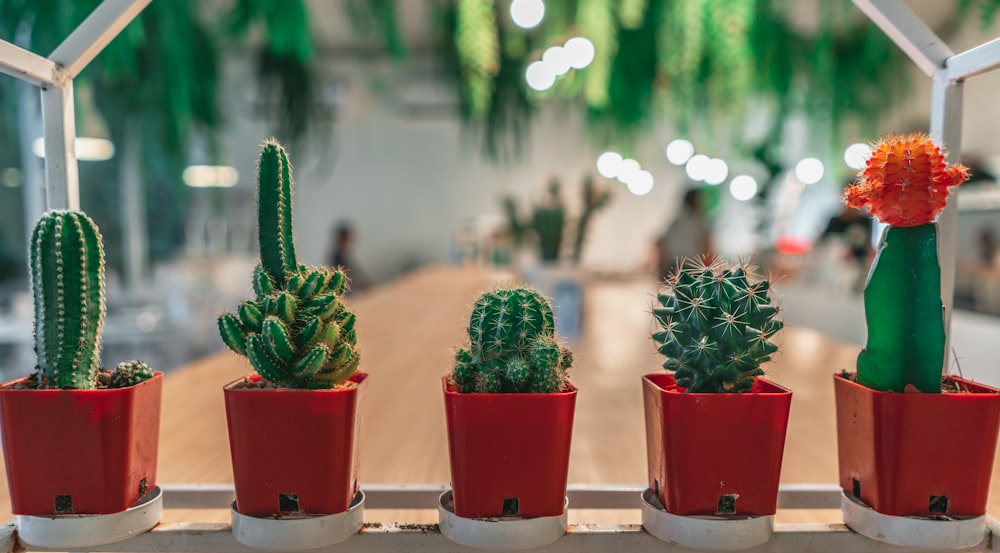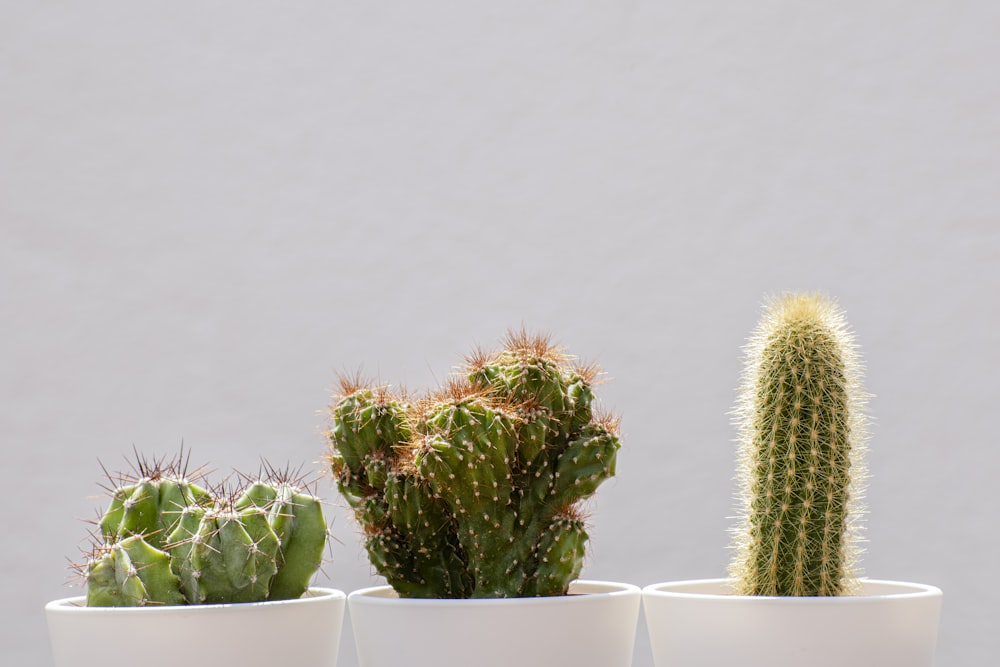Cacti are low maintenance plants that store water in their stems. They are found in hot, arid climates, like deserts, and therefore have adaptations to tolerate long periods of drought and minimize water loss. These features include a waxy outer coating and spines. Unlike normal leaves, cactus spines do not lose water through evaporation and protect the cactus from other predators. With the following tips, you can learn how to take care of a cactus indoors and ensure sure your cacti are nice and healthy. Once you know these tips, taking care of cacti is easy for beginners!
How to take care of a cactus:
When learning how to take care of a cactus, it is important to remember that they are native to the desert. Therefore, they enjoy warm, dry climates with infrequent watering.
1. Sunlight
Cacti thrive in high-light conditions.
To make sure your cactus gets the light it needs, place it near a window that receives at least 6 hours of bright light per day. Rotate your cactus plant periodically so that all sides receive sunlight equally and the growth is equal. Ideally, you want to place your cacti in a south-facing window, as these receive the most light. Avoid dark corners that do not receive any sunlight.
If you find that your cacti are not getting enough light despite being in front of a window, or you want to keep them somewhere in your house that does not receive light, consider getting a grow lamp. This way, you can be sure your cactus is getting the light it needs wherever you decide to keep it. I use a grow lamp indoors for my cacti and they seem to love it!
Signs your cactus is not getting enough light
If you notice the top growth of your cactus is becoming smaller and skinnier than the rest of the body, your plant is trying to “stretch out” for more sun. This is called etiolation. If you notice this is the case, transition your cactus to an area with more light. Unfortunately, this new, skinnier growth will be permanent and will not fatten out. If you do not like how it looks, cut it off with a pair of clean garden shears (don’t worry, this is fine for your plant and not as scary as it seems!). The cactus will be able to regrow and look “normal” if it is moved to an area with more light.

Learn more about etiolation and how to fix it
Signs your cactus received too much light
However, do not move your cactus directly from a shaded area to a bright sunny area. Even though cacti are desert plants, they can sunburn if exposed to bright light too quickly. If your cactus was originally in a shaded area, slowly transition it into sunlight over a week.
If your cactus is sunburned, the sunburned area will look brown and calloused, especially on the side facing the window. Unfortunately, once a cacti is sunburned, the area will not go away, so it is best to avoid sunburn in the first place by gradually exposing the cactus to increasing sun.
2. Water
I’ll admit I killed my first cactus from over watering because it was hard to believe that cacti truly are that low maintenance.
It is so important to remember cacti do not need as much water as normal houseplants. In fact, cactus plants need periods of drought in order to survive. Overwatering is one of the most common causes of cactus death.
Watering cacti can be tricky since overwatering can lead to rot. Rot starts at the roots and spreads upwards to the rest of the plant. Unfortunately, by the time you see signs of rot above ground, many of the roots are already dead and your cactus may not be able to be saved. Therefore, it is important to water appropriately from the start so you do not have this problem.
In general, cacti planted indoors should be watered about once a month. If your cactus is planted outdoors and you are in a hot, dry climate, it will need to be watered more frequently (around once every week or two). Before watering, check the moisture in the top few inches of soil: they should be completely dried out before you water again.
Cactus plants will also need less water during the winter, as little as once a month.
If in doubt, err on the side of underwatering. It is much easier to fix an underwatered cactus than an overwatered one.
Do not water your cacti every day, because it can kill them.
Signs of overwatering in cacti
Signs that your cactus is receiving too much water include:
- Becoming less stable
- Browning or blackening at the base of the cactus
- A droopier shape
- Feels mushy when you poke it
If you notice any of these signs, carefully remove the cactus and examine it’s roots- if you see any brown or black areas, it is rotting.
How to fix an overwatered cactus
- Remove any rotting potions of the cactus. These will appear brown or black. Unfortunately, they will not go back to green. Cut until you do not see any signs of rot on the inside. You may have to cut past the black parts into the green tissue to completely get rid of rot, because it spreads on the inside before signs appear on the outside.
- Replant the healthy cactus into a new pot with fresh well-draining potting soil.
- Do not water the cactus for a week after repotting to allow it to settle in.
Signs of underwatering in cacti
While not as common, it is possible to underwater a cacti. If you notice your cactus showing brown markings on the edge, turning brittle, shrinking, or puckering up, your cactus might not be receiving enough water. Slowly increase the frequency of waterings.
Always check to see if your soil is dry before watering.

3. Keep a warm temperature
Since cacti are native to the desert, it is natural that they enjoy warm, dry temperatures. Cacti like temperatures of about 70 – 90 °F (21 – 32 °C) in the summer and around 50 – 55 °F (10 – 13 °C) in winter months. Do not leave cacti in temperatures colder than that because they could get frostbite.
Avoid keeping cacti in rooms that can get humid (such as bathrooms) as that can lead to rot.
Pay careful attention to the temperature when deciding how much to water. Hot, dry climates will require more frequent watering (about twice a month) compared to colder climates (about once a month).
4. Best soils and pots for cactus care
The best types of pots for cacti are plain terracotta pots with drainage holes. These work best because they do not retain extra water – cacti hate staying wet for too long. These pots help the soil dry out faster and are much more forgiving if you water too often.
I recommend staying away from glass containers, and not planting cacti in terrariums when starting out because these can retain moisture for a long time. Once you have a better idea of a good watering schedule that works for your cacti, you can try these out, but in the beginning, terracotta work great!
It is important for cacti to be planted in a well draining, porous soil that does not retain water. Typical gardening soil for houseplants usually retains too much moisture for cacti and should not be used. I use a 70:30 ratio of succulent soil to perlite and find that that works best.
How often should you repot your cactus?
I recommend repotting every 3 years. Cacti can be repotted less often than other houseplants because they are slow growing and prefer being pot-bound.
The best time to repot is during the spring or summer time. Do not choose a very large pot because you could drown the roots. As always, choose a well-draining and porous soil.
After repotting, do not water for another week to allow the roots to settle in. If you water right after repotting, the roots are more prone to overwatering and you run the risk of rot.

5. Fertilizing your cactus
Cacti usually need little fertilizer. I tend to water with a succulent fertilizer once every 2 months during their growing season (March to September) and find this is enough to keep them healthy.
Avoid excessively fertilizing your cactus because it can burn the roots and disrupt growth.
6. How to take care of a cactus: What if my cactus gets scale?
Scale are small, round, brown bugs that are indoor houseplant pests. They suck on the liquids and nutrients in cacti. It can take several tries to completely cure your plants of this pest.
The good news about scale? They spread slowly: therefore the damage to your plant will also be slow, giving you more time to tackle the pests.
Once you notice scale:
First, quarantine whatever plants have scale, so the infestation does not spread further. Scale does not move, so you can scrape it off gently with a knife or card.
Then, take a q-tip, soak it in rubbing alcohol and dab it at any bugs you see. This does not harm your cactus and helps get rid of any infestation. If rubbing alcohol is not enough, diluted neem oil also works well to treat infestation. You will need to do this once a week for several weeks until you no longer see any bugs.
Regularly inspect your cactus for scale, since catching these pests early makes treatment much easier.
Mealy bugs on cactus
Mealy bugs are another common pest for cactus plants indoors. They are small, white and fuzzy, and often leave a powdery white residue on the leaves. Mealy bugs can quickly spread to other plants, so make sure you quarantine the infected ones. They especially like to hang out in the nooks and crannies, so pay special attention to checking those areas.
You can get rid of them the same way you would get rid of scale: take a q-tip soaked in rubbing alcohol and dab it at any bugs you see. You will need to do this quite frequently for several days/weeks to completely remove all signs of the bugs.
7. Rinse off dirt and dust frequently
When your cactus is covered with dust or dirt, it cannot absorb light properly. Every once in a while, take a damp napkin and gently wipe off any dust or dirt that may have collected to keep your cactus clean.
The most important part of learning how to take care of a cactus indoors or outdoors: have fun!
Do not get discouraged if your first few tries at growing cacti are unsuccessful and they succumb to rot.
These are my tips on how to take care of a cactus indoors or out and how to fix common mistakes beginners make when growing cacti.
By following this guide, you can get a better idea of how to take care of cacti and maintain happy and healthy plants.
Do you own a cactus? Have any questions I didn’t answer? Let me know below!


Related Articles:
How Often Should you Water Succulents and Cacti
Succulent Root Rot: What it is and How to Treat It
Succulent Etiolation: What to do if your Succulent is Growing Tall








